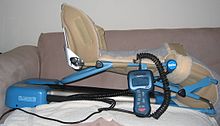- Continuous passive motion
-
Continuous passive motion (CPM) devices are used during the first phase of rehabilitation following a soft tissue surgical procedure or trauma. The goals of phase 1 rehabilitation are Control post-operative pain, Reduce inflammation, Provide passive motion in a specific plane of movement , and Protect the healing repair or tissue. CPM is carried out by a CPM device, which constantly moves the joint through a controlled range of motion, the exact range is dependent upon the joint, but in most cases the range of motion is increased over time.
CPM is used following various types of reconstructive joint surgery such as knee replacement and ACL reconstruction. Its mechanisms of action for aiding joint recovery are dependent upon what surgery is performed. One mechanism is the movement of synovial fluid to allow for better diffusion of nutrients into damaged cartilage (which would be unimportant in the event of joint replacement), and diffusion of other materials out; such as blood and metabolic waste products. Another mechanism is the prevention of fibrous scar tissue formation in the joint, which tends to decrease the range of motion for a joint. The concept was created by Robert B. Salter M.D in 1970 and, along with help from engineer John Saringer, a device was created in 1978.[1]
CPM Following Knee Arthroplasty
There is controversy concerning the effectiveness of CPM following Knee Arthroplasty. Some studies support knee arthroplasty, while others show little or no effect when compared with placebo. One assessment of multiple studies indicates that CPM following knee arthroplasty gives a total benefit of 0.69 days less in the hospital and 4 more degrees of motion (only at 2 weeks of follow-up) than physical therapy alone. This assessment further suggested that consideration must also be given to patient convenience and CPM cost.[2]
References
- ^ Clinical Orthopaedics and Related Research - Abstract: Volume 242() May 1989 p 12-25 The Biologic Concept of Continuous Passive Motion of Synovial Joints: The First 18 Years of Basic Research and Its Clinical Application.
- ^ Brosseau L, Milne S, Wells G, Tugwell P, Robinson V, Casimiro L, Pelland L, Noel MJ, Davis J, Drouin H. (2005) Continuous Passive Motion Improves Active Knee Flexion and Shortens Hospital Stay but Does Not Affect Other Functional Outcomes After Knee Arthroplasty. THE JOURNAL OF BONE & JOINT SURGERY. VOLUME 87-A. NUMBER 11
External links
Categories:- Therapy
- Rehabilitation medicine
Wikimedia Foundation. 2010.

